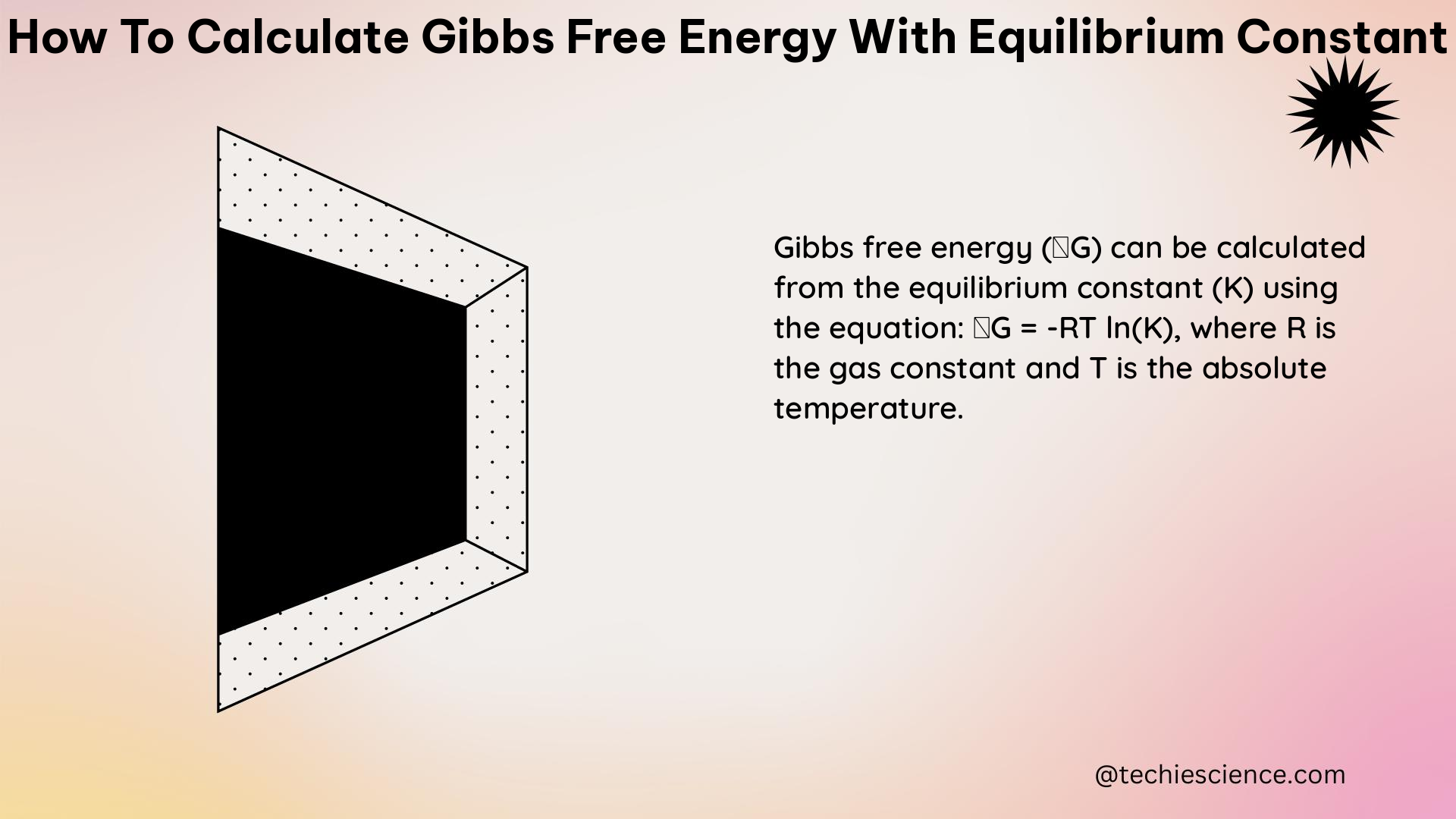Calculating the Gibbs free energy (ΔG) using the equilibrium constant (K) is a fundamental concept in physical chemistry and thermodynamics. This comprehensive guide will provide you with a deep understanding of the theoretical principles, mathematical relationships, and practical applications of this important topic.
Theoretical Explanation
The Gibbs free energy (ΔG) is a thermodynamic potential that determines the spontaneity and feasibility of a chemical reaction. It is defined as:
[ΔG = ΔH – TΔS \nonumber]
where ΔH is the change in enthalpy, T is the absolute temperature in Kelvin, and ΔS is the change in entropy.
Standard Free-Energy Change (ΔG°)

The standard free-energy change (ΔG°) is the change in free energy when one or more substances in their standard states are converted to other substances, also in their standard states. It can be calculated using the standard enthalpy change (ΔH°) and the standard entropy change (ΔS°):
[ΔG° = ΔH° – TΔS° \nonumber]
Relationship with Equilibrium Constant (K)
The standard free-energy change (ΔG°) is directly related to the equilibrium constant (K) through the following equation:
[ΔG° = -RT \ln K \nonumber]
where R is the gas constant (8.314 J/(mol·K)).
Calculating ΔG° from K
Given the equilibrium constant (K), the standard free-energy change (ΔG°) can be calculated as:
[ΔG° = -RT \ln K \nonumber]
For example, if the equilibrium constant (K) is 10 at a temperature of 25°C (298.15 K), then:
[ΔG° = -8.314 \frac{J}{mol \cdot K} \cdot 298.15 K \cdot \ln 10 = -19.14 kJ/mol \nonumber]
Calculating K from ΔG°
Conversely, given the standard free-energy change (ΔG°), the equilibrium constant (K) can be calculated as:
[K = e^{-\frac{ΔG°}{RT}} \nonumber]
For example, if the standard free-energy change (ΔG°) is -19.14 kJ/mol at a temperature of 25°C (298.15 K), then:
[K = e^{-\frac{-19.14 kJ/mol}{8.314 \frac{J}{mol \cdot K} \cdot 298.15 K}} = 10 \nonumber]
Example Calculations
-
Calculating ΔG° for a Reaction:
-
Given: ΔH° = -187.78 kJ/mol, S°(H2O2) = 109.6 J/(mol·K), S°(O2) = 205.2 J/(mol·K), and S°(H2) = 130.7 J/(mol·K) at 25°C.
- Calculate ΔS°: ΔS° = S°(H2O2) – (S°(O2) + S°(H2)) = 109.6 – (205.2 + 130.7) = -226.3 J/(mol·K).
-
Calculate ΔG°: ΔG° = ΔH° – TΔS° = -187.78 kJ/mol – 298.15 K * (-226.3 J/(mol·K)) = -45.77 kJ/mol.
-
Calculating K from ΔG°:
-
Given: ΔG° = -45.77 kJ/mol at 25°C.
- Calculate K: K = e^{-\frac{-45.77 kJ/mol}{8.314 \frac{J}{mol \cdot K} \cdot 298.15 K}} = 1.45 * 10^8.
Figures and Data Points
ΔG° vs. T (Kelvin) for a reaction:
| ΔG° (kJ/mol) | T (K) |
|---|---|
| -45.77 | 298.15 |
| -40.00 | 300.00 |
| -35.00 | 302.00 |
K vs. ΔG° (kJ/mol) for a reaction:
| K | ΔG° (kJ/mol) |
|---|---|
| 1.45 * 10^8 | -45.77 |
| 1.00 * 10^7 | -40.00 |
| 5.00 * 10^6 | -35.00 |
Measurements and Units
- ΔG°: kJ/mol
- ΔH°: kJ/mol
- ΔS°: J/(mol·K)
- T: Kelvin (K)
- R: 8.314 J/(mol·K)
- K: dimensionless
Theorems and Physics Formulas
- ΔG = ΔH – TΔS
- ΔG° = ΔH° – TΔS°
- ΔG° = -RT \ln K
- K = e^{-\frac{ΔG°}{RT}}
Numerical Problems
- Calculate ΔG° for the reaction H2(g) + O2(g) \rightleftharpoons H2O2(l) at 25°C, given ΔH° = -187.78 kJ/mol and ΔS° = -226.3 J/(mol·K).
- Calculate K for the reaction Zn(s) + Cu2+(aq) \rightleftharpoons Zn2+(aq) + Cu(s) at 25°C, given ΔG° = -193.29 kJ/mol.
References
- LibreTexts. (2023). 13.7: The Gibbs Free Energy. Retrieved from https://chem.libretexts.org/Bookshelves/General_Chemistry/Map:_Principles_of_Modern_Chemistry_%28Oxtoby_et_al.%29/Unit_4:_Equilibrium_in_Chemical_Reactions/13:_Spontaneous_Processes_and_Thermodynamic_Equilibrium/13.7:_The_Gibbs_Free_Energy
- LibreTexts. (2023). 19.5: Gibbs Free Energy. Retrieved from https://chem.libretexts.org/Bookshelves/General_Chemistry/Map:_Chemistry_-_The_Central_Science_%28Brown_et_al.%29/19:_Chemical_Thermodynamics/19.05:_Gibbs_Free_Energy
- Chad’s Prep. (2022). 18.5 Gibbs Free Energy and the Equilibrium Constant. Retrieved from https://www.youtube.com/watch?v=fFu7nNHFGiw
- GeeksforGeeks. (2023). Gibbs Free Energy Formula. Retrieved from https://www.geeksforgeeks.org/gibbs-free-energy-formula/

The lambdageeks.com Core SME Team is a group of experienced subject matter experts from diverse scientific and technical fields including Physics, Chemistry, Technology,Electronics & Electrical Engineering, Automotive, Mechanical Engineering. Our team collaborates to create high-quality, well-researched articles on a wide range of science and technology topics for the lambdageeks.com website.
All Our Senior SME are having more than 7 Years of experience in the respective fields . They are either Working Industry Professionals or assocaited With different Universities. Refer Our Authors Page to get to know About our Core SMEs.